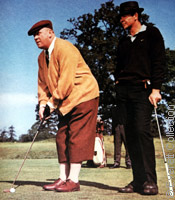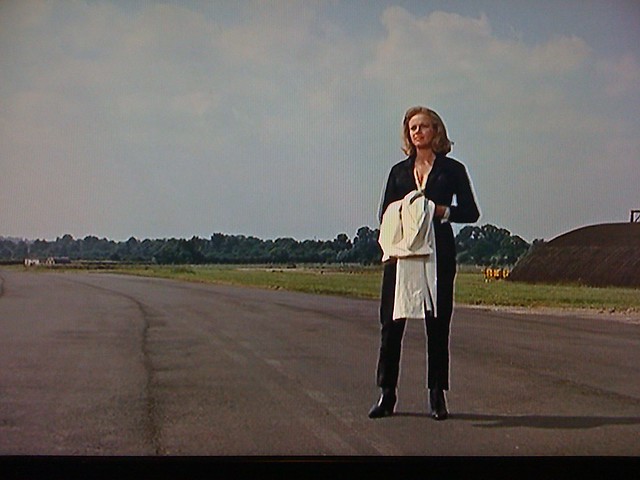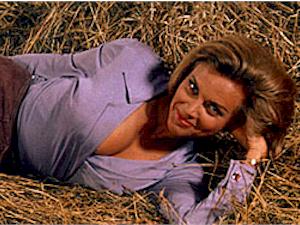So I begin my analysis of the third James Bond film, Goldfinger, with a huge “GULP,” knowing that it is probably most people’s favorite film. Here’s hoping I don’t lose my entire readership — although I think I’m safe as the film holds up extremely well and may be the truly iconic Bond film of the series.

Bond, James
We begin as we always do, with Sean Connery’s portrayal of 007. His performance continues to evolve following his first two outings. Whereas he began to settle into the role in From Russia With Love, at this point he is more than just relaxed in it. He owns it. There is a sense that he is a full-blown agent now, that he’s been on countless missions, and his charm and grace are being pushed to the forefront. The more brutal qualities he exhibited in the first two films are toned down, while the British sophistication is far more evident. This is also consistent with the more playful tone of the movie (more on that shortly). The harder edges of masculinity that were showcased in the first two movies recede just a bit into the background. Mr. Connery is seen more often in suit and tie, and for that matter, the suits themselves feel to be of a classier cut.
There is a warmer side to Bond this time, as well. Viewers will remember that he did not need to save Honey Ryder as Dr. No’s lair crumbled in the first film. She was a true innocent. In Goldfinger, Bond clearly feels responsible for the death of Jill Masterson. Bond seduces her, causing her to betray Goldfinger as he cheats at cards. When Oddjob later kills her via epidermal suffocation by painting her gold, M confronts Bond regarding his ability to handle the mission objectively. Her death clearly weighs on his conscience, though we only see it for a moment or two. Interestingly, this is one of at least three occasions in which it is suggested that Bond is motivated by revenge (the others being License to Kill and Quantum of Solace). It’s a bit odd for him to feel so strongly for a woman he certainly didn’t love. The subtext, then, is that Bond in fact carries a guilty conscience over Masterson’s death. Later, when he inadvertently exposes Jill’s sister Tilly, and she ends up dead at the hat of Oddjob, one can only conclude that Bond now has a double case of guilt to deal with.
As we push forward with the series, it should be interesting to see how Bond reacts in regards to the women he seduces. Is his protectiveness the result of true feelings he develops as a result of each seduction….or of a guilty conscience? We shall see.
The Man with The Midas Touch
Auric Goldfinger stands apart from almost every other Bond villain. Most of them pretty much want to rule the world, destroy the world, or cause global havoc. On the surface, Goldfinger wants gold. However, his behavior and the eccentric performance of Gert Frobe (and dubbed by Michael Collins) suggest he is motivated by a deeper psychology. There is a subtext at work in the character — that of a rather small and petty man desperately seeking respect.

He cheats at cards, instead of using an obviously superior intellect to win honestly. He punishes Masterson’s minor betrayal by murder. Why such a harsh punishment? Because his fragile ego was shattered and he was embarrassed when told to lose at cards.
He cheats at golf, having Oddjob “find” his golf ball when it is lost in the rough. He even cheats in his grand plan — murdering all the mobsters who helped piece together Operation Grand Slam, even the one who said he wanted out and was made to believe he would receive his payment.
He surrounds himself with beautiful women, but apparently isn’t sleeping with them. Masterson makes it quite clear that she is paid only to be seen with Goldfinger. Pussy Galore makes it clear that she’s only being paid as his pilot.
The scene in which he reveals his plan to the mobsters is all about Goldfinger showing what a big man he is — as he pompously lays out his plan for all to see and hear. I might be reading too much into certain visuals — no jokes, you vandals — but holding the pool cue right at waist level as he points to the image of Fort Knox is about as phallic an image as one is going to see. And his ranch in Kentucky isn’t a ranch. It’s a stud. And in case that’s lost on you, we not only see the sign indicating it as such but Auric greets Bond with, “Welcome to Auric Stud, Mr. Bond.” Heck, may as well point out the tall pillars that grace the front of the mansion there, as well, not to mention the large laser pointed right between Bond’s legs.

He’s also a show-off, like all people with fragile self-esteem. Everything we see regarding Goldfinger in production design and wardrobe is gold — his car, his recreation room, even the inside of his airplane.

There’s also an arguable plot hole that could be dismissed based upon the relationship between Goldfinger and Bond. In the famous laser sequence, Bond bluffs his way out of being cut in half by saying he knows all about Operation Grand Slam. There’s really no reason for Goldfinger to keep him alive, whether Bond knows about it or not. One interpretation is that Goldfinger wants Bond around because he wants to be Bond. He wants Bond’s respect. Here is this British gentleman — the upper-crust of spies — who dresses in suits and ties, plays golf, and drinks Dom Perignon.
Meanwhile, Goldfinger’s wardrobe is rather drab and ratty. Tans, golds, brown, tweeds. Yuck. It’s very lower-class. Heck, his “star entrance” drastically contrasts that of Dr. No’s. Whereas the latter was filled with mystery and later a cool detachment, Goldfinger first appears a bulbous Pac-Man, dressed in ugly yellow swimwear more suited to the geriatric denizens of Miami Beach rather than the hip poolside setting he plays cards in.

The scene with Bond and Goldfinger at the stud, talking over mint juleps (not exactly a high-glass drink, with apologies to Kentuckians), is very telling. Just watch Goldfinger as he lays out his plan, gently teasing Bond into figuring it out. He LOVES his plan. He LOVES that Bond loves it! He LOVES that he earns Bond’s respect. The truth is he’s flattered that he’s got the attention of both the CIA and MI6. It’s also a character-driven method by which the villain reveals the rest of his grand plan, rather than just monologuing.
All in all, Auric Goldfinger is an interesting and engaging villain because his plot is centered around his own character flaw. This doesn’t happen too many times in the Bond series.
Tone and Theme
From Russia with Love‘s theme was chess. This time around the theme, other than the obvious, fits with the film’s overall playful tone: games. The almost genial rivalry between Bond and Goldfinger contrasts starkly with the intellectual Cold War manipulations of From Russia. Goldfinger is introduced playing gin rummy, and Bond squelches his victory by literally playing with his cheating partner. Then we move to the golf course, where a game of ball-switching goes on within the golf game itself. Bond literally bluffs his way out of his laser predicament, as would befit a game of poker.


The Auric Stud is introduced with shots of men harness racing. Goldfinger’s presentation of Operation Grand Slam (a baseball term) includes a life size game board of Fort Knox and the surrounding area. On Goldfinger’s jet, the Korean stewardess is told to spy on Bond in the bathroom. Three times she tries to peep at him, each time he frustrates her by blocking her eyepiece. When Bond is incarcerated at the Stud, he plays a game of peek-a-boo with the guard as a ruse for escape. Finally, the CIA and the Army engage in an elaborate game of pretend, as they literally play dead as Goldfinger’s gas-laden planes roar overhead.
Design
From Russia With Love was, from a design standpoint, also reflective of the film’s tone. The film feels gritty, dirty, and earthy. Goldfinger’s look is, well, polished. Most of the scenes have a high degree of contrast associated with them. The shot design often places individuals within wide, sweeping shots. It may be Bond on a mountain road.
It’s Oddjob framed against a wide open sky.
It’s Pussy Galore set against a flat landscape.

It’s Pussy’s airplanes sweeping over Fort Knox, or Bond creeping alongside massive circular oil tanks. It’s Bond and Goldfinger are solitary figures on a huge golf course.

The choice of composition and lighting in almost every scene gives many of the scenes a visual pop. Foregrounds are starkly separated from backgrounds. Individual elements with each frame are sharply delineated. The contrast is even apparent in character — Bond vs. Goldfinger. The effect gives Goldfinger the feeling of a sweeping adventure, in contrast to the claustrophobia of From Russia With Love, especially on board the train.
The bravura set for the vault at Fort Knox is really worth noting. The vault has nice visual flare thanks to lots of contrasting lines (verticals and horizontals), and contrasting shapes (the circular vault door to the rectangles of the vault). Even the cylindrical bars which electrocute Oddjob are themselves stacked as vertical lines. Design students will remember that the point is to provide viewers with a subconscious feel of dissonance. As this is the suspenseful conclusion, it works rather well. The effect is heightened by the lack of orchestral score. Just as with the climactic fight in the previous film, Bond’s smackdown with Oddjob only has the sounds associated with the scene itself, heightening the tension.

Women
Honor Blackman portrays Pussy Galore as a highly capable woman — a no-nonsense pilot who has trained a cadre of other capable women. As Bond women go, she’s one of the best — beautiful, with a stunning figure, gorgeous blue eyes, and physically adept. Women make it a point in the film to let Bond know that they are not being used as sex toys. In fact, Bond has to crack Pussy’s tough exterior before winning the literal roll in the hay. In addition, this is the first film where Bond’s seductions directly serve the story. It is that roll in the hay that allows Bond to win Pussy over and turn the tables on Goldfinger’s plan.

Boo-Boo’s
Goldfinger only suffers from two plot bumbles. In the opening sequence, after blowing up a bad guy’s operation, Bond returns to his hotel room against the advice of his contact. Why? “For some unfinished business.” He enters, kisses a woman we know nothing about, is ambushed by some bad guy, defeats him, and walks out on the woman.
Huh?
I know the opening sequences often have little to do with Bond films, but the degree of pointlessness of this one was really frustrating.
By now, the producers were obviously struggling with how to reveal the villain’s grand plan. They got away with in in Dr. No because it was the first film and No had a degree of motivation to let Bond in on his plan. In the second film, Robert Shaw has the drop on 007 and says, “I don’t mind telling you what we’re up to.” Well, that was pretty clumsy. This time, however, Goldfinger gathers all the mobsters together, tells him his evil plan…and then kills them all. Why? Apparently so Bond can overhear the entire plan while hidden beneath the life size Fort Knox board game.
There’s some clumsy undercranking that speeds up some of the action, which looks silly. But those are balanced by some nice miniature work, such as the crash of Pussy’s plane.
Overall, Goldfinger really does hold up. It’s an instructive paradigm for the series — a nice balance between a realistic spy film and heightened reality, totally entertaining, with great characters, and another fine turn by Mr. Connery.

James Bond will return in Thunderball.

COMMENTS
Please let us know if you're having issues with commenting.